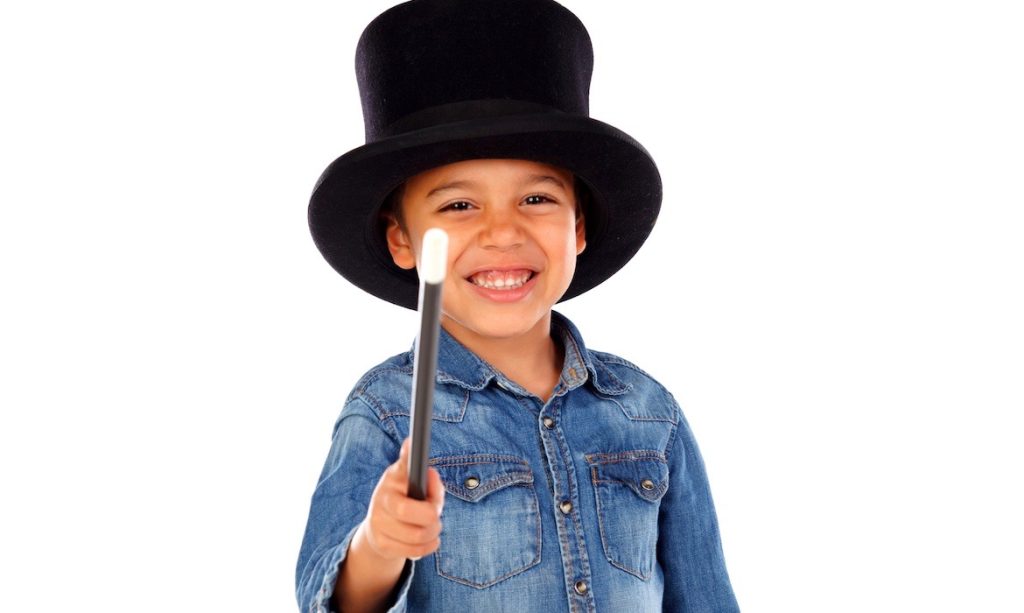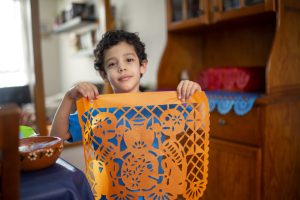- Magician’s Tricks is a fun game for families that helps young children learn and practice counting skills and number relationships.
- Counting involves many different concepts and skills.
- Magician’s Tricks can be personalized to help your child practice their counting skills and develop new ones.
About the Game
In Magician’s Tricks, your child will use magic to figure out what number is on hidden cards that the other player picks. (The magic consists of clever counting!) All you need to play are some numbered cards, which makes this game easy to play anywhere you need to entertain your child. You can use playing cards, print these 0-20 counting cards, or make your own using sticky notes, index cards, or even torn up paper (such as a children’s restaurant menu). Cards are laid out in order (1-10) and then turned facedown. Your child—the magician—will ask you to “pick a card, any card” and then tell you what card you picked using magic. The first few times you play, choose a small number and see if your child counts from 1 to figure it out. If not, model for your child how to secretly count the cards to figure out what card was chosen. Your child might have so much fun showing off their magic tricks, they won’t even know they’re learning new ways to use counting!
Early Counting Skills
Counting is one of the most important math skills young children need to learn. Preschoolers and kindergartners need to count to participate in their classroom, and they need to know how to count to learn more advanced math like arithmetic.
Although counting seems simple, children need to learn many different things on the path to becoming counters.* To start counting objects, children need to be able to say one number word for each object they count without skipping or counting any object twice. Of course, they start by counting a small number (like 5) and as they get better at it, they can count higher and higher (like 10 and then 20 and beyond). As children progress to higher numbers, they also start to read written numbers. Later on, children are able to count backward. Then, they can start counting forward or backward from numbers other than 1.
Personalizing the Game for Your Child
Whether your child is just starting to count or is ready for more advanced counting skills, like counting backward, Magician’s Tricks can be adapted to help them practice the counting skills they already have and learn new ones.
You can support your child wherever they are on their path to developing counting skills by making small adjustments to the game. Below are some ideas to personalize Magician’s Tricks to help your child move to the next counting skill. Suggestions at the top of the list focus on earlier counting skills and suggestions at the bottom challenge children to develop harder counting skills.
- If your child is skipping a card or counting a card twice: Have your child count the cards with you while they touch each card with their finger (or their magician’s wand!). If that doesn’t help, you can also point or hold your child’s hand to help them point.
- If your child is counting small numbers: Put out a few more cards than what your child can count. If they can count up to 3, put out cards 1-5. Keep adding more cards as they can count higher.
- If your child is counting to 10 or higher: In addition to using higher cards, like 1-20, use cards that just have numbers (no dots or symbols). Start encouraging your child to count backward. Pick a higher card towards the end of the row. After your child tells you what card you picked, ask them how they knew. If they show you how they counted forward to figure it out, point to the last card and ask if they can count back from 10.
- If your child can count backward: Start by choosing the 9-card to encourage your child to count down from 10. Extend to 8 or 7.
- If your child can count forward or backward from any number: Keep the cards you choose faceup so your child can count from those cards instead of from 1. Start the game normally but after they identify your card, leave it faceup with the number showing. Continue the game by picking a card right before or right after the faceup card you just chose and encourage them to start counting from the card that is faceup. For example, if the 3-card is face up and you point to the 4-card, encourage the child to start counting from the 3-card instead of the 1-card.
Build Language and Thinking Skills
Math has been found to be one of the most important subjects for children to learn, not only because the math itself is important, but also because it allows children to develop language and other thinking skills. You can help your child learn the most math and help grow their language, planning, and problem-solving by discussing what your child does with them. Below are examples of questions to ask while playing Magician’s Tricks.
- After your child tells you the card you picked, ask: “How did you know that number?”
- When your child answers by showing how they counted up to the correct card, ask: “Is there another way you can find that number?” (For example, you could encourage your child to count backward from the highest number like “10…9…8…7…6…5. 5!”)
- If you are playing by leaving cards face-up, ask questions like, “What number comes before (the face-up number)?” “What number comes after (the face-up number)?” and “What number is two less than (the face-up number)?”
We Want to Hear from You!
We want to know how you used this activity. What adaptations worked for your family? What did your child like about the game? We also welcome any questions you may have. Please send your stories and questions to contactdreme@stanford.edu.
*For a full explanation of children’s development of counting skills, visit our website at LearningTrajectories.org.



